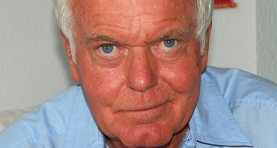
Jon Taylor is a Cambridge-trained scientist and author who has developed physical theories of precognition and intuition, bridging quantum physics and neuroscience.
Career
Jon Taylor is an interdisciplinary scientist with an MA in Natural Sciences from Cambridge University. His career spans scientific instrument research, marketing, petroleum exploration and filmmaking. In 1993, he embarked on a study of precognition and intuition, presenting his theories at Parapsychological Association conventions and publishing in peer-reviewed journals. His work culminated in The Nature of Precognition (2014) and research on intuition presented in Paris (2019). Taylor's book, Contact with the Future, was revised and republished in August 2024. He maintains professional memberships in scientific organizations including the Parapsychological Association and Society for Scientific Exploration.
The Nature of Precognition
Taylor proposes a theory explaining precognition as a connection with the percipient's future brain—literally ‘pre-cognition’ of information contained within their future experience. The theory is based upon the block universe model, in which past and future events already exist in the space-time continuum, as required by the special theory of relativity. Combining this model with David Bohm's concept of the implicate order, Taylor suggests similar neuronal patterns created at different times resonate, becoming more similar to each other. Precognition occurs when the pattern activated during a future experience resonates with a similar pattern spontaneously activated in the present. The resonance sustains activation of the present pattern until the threshold for conscious awareness is reached. The theory addresses the intervention paradox and explains experimental anomalies in target-guessing tests. Taylor eliminates the need for direct clairvoyant contact with external objects, instead viewing precognition as the fundamental psi phenomenon, with telepathy possible but more difficult due to different brains being involved. The model rejects metaphysical explanations, and operates within materialist frameworks.1
Human Intuition
Taylor extends his precognition model to explain intuition as the detection of an absence of resonance between present and future patterns. When someone intends to perform an action but will be unable to fulfill the intention in the future (for instance due to an accident), there is no resonance between patterns corresponding to present intention and future experience. This absence serves as an intuitive warning. The model explains why intuitive feelings seem vague—they involve deducing potential dangers rather than directly perceiving them. Taylor applies this mechanism to explain forced-choice target-guessing experiments, where participants systematically eliminate incorrect options through intuitive warnings. Railway passenger statistics shows that fewer people travel on trains involved in accidents, supporting the notion that people unconsciously tend to avoid dangerous situations. Taylor suggests that intuition operates most effectively over shorter time intervals when neuronal patterns are less affected by brain plasticity. The model proposes that intuition works by detecting knowledge that an intended future will not occur, and this allows for preventative actions being taken without confronting the intervention paradox.2
Memory and Precognition
Taylor proposes that memory retrieval and precognition function through similar mechanisms. Utilizing Bohm’s quantum theory, he suggests that when similar neuronal spatiotemporal patterns are activated at different times, they resonate and influence one other. When retrieving memories, impulses follow various pathways until one matches the pathway activated during the initial experience, causing resonance that sustains the activation. Since resonances can occur across time, retrieval from the future works similarly to retrieval from the past. Resonance strength increases with emotional significance and decreases with temporal distance, explaining why significant events and recent memories are more easily recalled. The theory addresses the intervention paradox by explaining that one cannot precognize an event they would change, since present and future patterns wouldn’t match. Taylor applies this framework to target-guessing experiments, suggesting participants access future knowledge of whether they’ve guessed correctly, rather than directly perceiving targets. This eliminates the need for clairvoyant interpretation and simplifies ESP by positioning precognition as the fundamental phenomenon.3
Contact with the Future
In Contact with the Future (2024), Taylor presents a scientifically grounded exploration of precognition and intuition. The book examines laboratory evidence for ESP before introducing a revolutionary theoretical framework based on David Bohm’s quantum mechanics. Taylor proposes that our brains can connect with future knowledge through quantum correlations between present and future brain states, elegantly avoiding backward causation paradoxes. He applies this model to explain various phenomena including remote viewing, dowsing and animal instincts, while demonstrating how intuition serves as a survival mechanism. The work bridges neuroscience and quantum physics, offering both theoretical understanding and practical applications for harnessing intuitive abilities in daily life, particularly for avoiding harm and making better decisions.4
Michael Duggan
Literature
Taylor, J. (2007). Memory and Precognition. Journal of Scientific Exploration 21/3, 553-71.
Taylor, J. (2014). The Nature of Precognition. Journal of Parapsychology 78/1, 19-38.
Taylor, J. (2019). Human intuition. Paper presented at the 62nd Annual Convention of the Parapsychological Association, Paris, France, 4-6 July 2019.
Taylor, J. (2024). Contact with the Future: The Astonishing Power of Intuition and Precognition. Paperback and ebook: Amazon.

